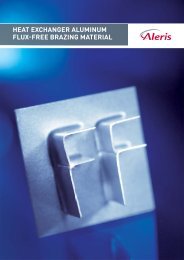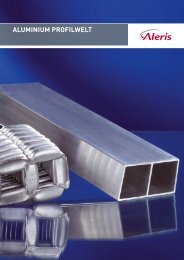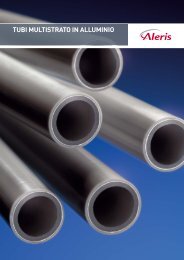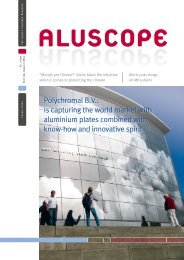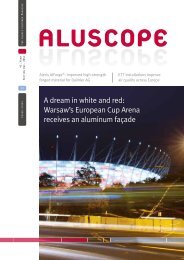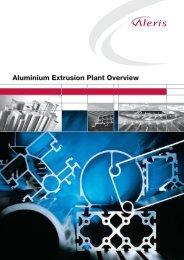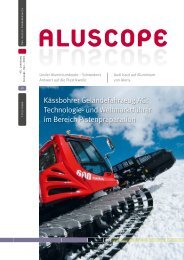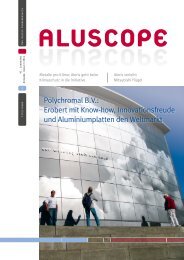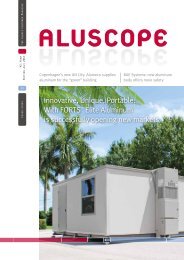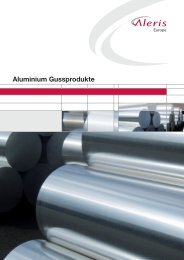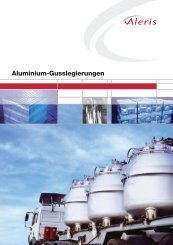You also want an ePaper? Increase the reach of your titles
YUMPU automatically turns print PDFs into web optimized ePapers that Google loves.
Surface treatment: corrosion<br />
and corrosion protection<br />
<strong>Aluminium</strong> casting alloys – like wrought<br />
aluminium alloys – owe their corrosion<br />
resistance to a thin, tenacious coating<br />
layer of oxides and hydroxides. In the pH<br />
range from 4.5 to 8.5, this oxide layer is<br />
practically insoluble in aqueous media<br />
and aluminium casting materials suffer<br />
only negligible mass disappearance.<br />
This passivity can, however, be annulled<br />
locally at weak points in the oxide layer<br />
due to the action of water containing<br />
chloride. Since the aqueous medium,<br />
e.g. weather, only acts periodically, a<br />
protective oxide layer forms again at<br />
small, local corrosion sites, e.g. repassivation<br />
occurs. Deep pitting corrosion<br />
can only arise when there is a long-term<br />
effect from aggressive water containing<br />
chloride (e.g. sea water). Beside the<br />
chloride content, the amount of oxygen<br />
in the water also plays a role; corrosion<br />
reaction can only occur in neutral media<br />
(pH = 4.5-8.5) in the presence of<br />
oxygen. The remedy for this can come<br />
in the form of passive protection by<br />
coating or by means of active cathodic<br />
corrosion protection using a sacrifi cial<br />
anode, for example.<br />
Magnesium as an alloying element<br />
causes the formation of a thicker oxide<br />
layer containing MgO and, consequently,<br />
provides greater corrosion protection<br />
against water containing chlorides and<br />
48<br />
<strong>Aluminium</strong> <strong>Casting</strong> <strong>Alloys</strong><br />
slightly alkaline media (e.g. ammonia<br />
solutions) since magnesium oxide in<br />
contrast to aluminium oxide is insoluble<br />
in alkaline solutions.<br />
Copper as an alloying element causes<br />
a deterioration in corrosion properties.<br />
This increases slightly with a rising Cu-<br />
content in the range below 0.2 % copper,<br />
above 0.2 to 0.4 % more strongly.<br />
Already with a Cu-content of 0.2 %,<br />
permanent action from aqueous solutions<br />
containing chlorine can have a very<br />
negative effect on corrosion behaviour.<br />
The negative infl uence of iron on cor-<br />
rosion behaviour is not as distinctive<br />
as that of copper. With an Fe-content<br />
of up to 0.6 %, there is no signifi cant<br />
deterioration in the corrosion behaviour<br />
of casting alloys.<br />
The surface treatment of aluminium cast<br />
products is carried out to improve their<br />
corrosion resistance, for decorative<br />
purposes or to increase the strength<br />
of the components.<br />
A homogeneous, non-porous cast struc-<br />
ture free from shrink holes and cracks<br />
makes coating easier. The quality of the<br />
coating is infl uenced decisively by the<br />
pre-treatment.<br />
Wiping, immersion and steam degreasing<br />
(in that order) produce increasingly<br />
grease-free surfaces without removing<br />
the surface oxide fi lm. Grinding, brush-<br />
ing, abrasive blasting or polishing do not<br />
remove the oxide fi lm completely and,<br />
as a rule, act as a preparation to further<br />
surface treatment. Possible sources of<br />
defects leading to subsequent faults<br />
comprise the use of brushes made of<br />
brass or non-stainless steel as well as<br />
sand or steel shot.<br />
When grinding, the use of ceramic<br />
grinding elements without further pretreatment<br />
frequently leads to good paint<br />
adhesion. One precondition is that no<br />
fi nes from the grinding elements are<br />
pressed into the surface of the casting.<br />
Chemical degreasing agents with<br />
a pickling or etching effect remove the<br />
oxide layer and, as a consequence, all<br />
impurities. It is also worth mentioning<br />
that there is also matt or bright pickling<br />
before anodic oxidation to produce a<br />
special surface fi nish.<br />
Following the alkaline pickling of AlMg<br />
or AlSi casting alloys, the pickling fi lm<br />
must be removed by means of an acid<br />
after-treatment with nitric acid, nitric/<br />
hydrofl uoric acid or sulphuric/hydrofl<br />
uoric acid. Instead of alkaline pickling<br />
with fi nal dipping, it is more benefi cial<br />
to use an acidic fl uoride-containing<br />
pickling solution immediately.




